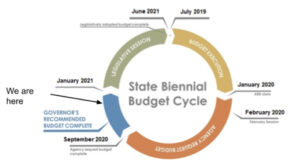
The State of Oregon operates on a biennial budget cycle – meaning a new budget is created and passed every two years. As you can see above, it’s a long process with a lot of different steps and stakeholders. Right now, we’re in the period between the Governor’s Budget becoming public, and the start of the Legislative session.
What is the Governor’s Recommended Budget?
Most importantly, it’s a document that represents the Governor’s values and priorities for funding and programs in our state. It’s not final, nor does it mean changes will be made to Agency operations immediately. However, it does provide a starting place for the Legislature and advocates in terms of Agency and programmatic funding and revenues available. The full document can be found here.
What can we learn from reading the Governor’s Budget?
- Governor Brown’s recommended budget is the first step in developing the 2021-23 state budget. THIS IS NOT THE FINAL BUDGET. Virtually every line item impacts SEIU members and the services we provide, and this is just the beginning.
- The Governor’s budget focuses on key challenges facing Oregonians: the public health and economic impacts of COVID-19, recovering from the tragic wildfire season, and addressing systemic racism and racial disparities in Oregon.
- SEIU members have been impacted by these simultaneous crises, like all Oregonians; however, we have also played the role of essential workers. For SEIU members, the budget directly impacts our livelihoods and the safety of ourselves and our families.
- Here’s how some of SEIU’s top priorities show up in the Governor’s Budget:
- Salary pots: $190M for state workers; $20M for HCW/PSW
- Investing in Long-Term Care: the budget includes $17.9 M to fund strategies to better serve aging Oregonians and the workers who support them
- Protecting investments: Ensuring that investments we won in 2019 are preserved, like hiring at Child Welfare and retirement for Homecare workers
- Protecting services all Oregonians rely on: Housing supports, health care, behavioral health, and continued COVID-19 response
- Oregon will not be able to balance a budget and move towards recovery without federal assistance and relief. It’s important for SEIU members to contact our federal delegation to get the assistance Oregon needs to fund the services we provide.
What comes next?
- As stated above, the GRB is the first step in the budget process.
- The Legislative session will begin on January 19th, and Agency budgets will begin to be discussed.
- In February the Office of Economic Analysis will produce another Economic and Revenue Forecast that will give us an updated picture of the impacts of COVID-19 on the economy, and tell us what resources are available for the budget.
- Sometime after that forecast, likely in late February or March, the Legislature’s Ways & Means Co-Chairs will release their initial budget plan, called the “Co-Chairs Budget.”
- After that is released, Legislative subcommittees (budget committees) will hold hearings on “Budget Areas” (i.e. Human Services, Public Safety, etc) and specific Agency budgets. During this time they usually hear from Agencies and members of the public – including SEIU members.
- There will be another revenue forecast in May that the Legislature will use to base their final budget on.
- The Legislature is bound by the Oregon Constitution to conclude its business by June 28th of 2021, so the budget will be passed and finalized by that time.
How can we get involved as SEIU members?
- Get involved with our 2021 Bargaining Campaign – “I am Essential.”
- Make sure you get SEIU emails about bargaining and updates from the Legislative session. Reach out to us if you aren’t sure!
- Join an SEIU 503 lobby day in the “virtual” Capitol! Talking to decision-makers in Salem is one of the most important things we can do to advocate for our fellow members in the budget AND win a strong contract. Details will be coming soon.
